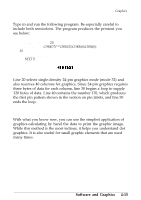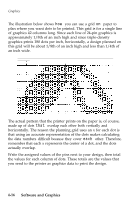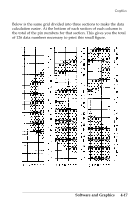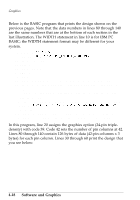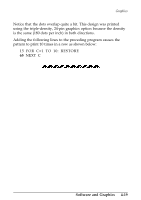Epson ActionPrinter 4000 User Manual - Page 105
Column Reservation Numbers, A Simple Graphics Program
 |
View all Epson ActionPrinter 4000 manuals
Add to My Manuals
Save this manual to your list of manuals |
Page 105 highlights
Graphics Column Reservation Numbers The graphics command requires more than one number to specify how many columns to reserve because one line can use thousands of columns, but the printer does not use numbers larger than 255 in decimal. Therefore the graphics mode command uses two numbers, n1 and n2, for reserving columns. To find n1 and n2, divide the total number of columns by 256. The result is n2; the remainder is n1. Since the command is set up for two numbers, you must supply two even if you need only one. When you need fewer than 256 columns, just make n1 the number of columns you are reserving and make n2 a zero. For example, if you wish to send 1632 columns of graphics data, n1 should be 96 and n2 should be 6 because 1632 = 96 + (6 x 256). The printer interprets the number of bytes specified by n1 and n2 as graphics data, no matter what codes they are. This means that you must be sure to supply enough bytes of graphics data or the printer will stop and wait for more data and will seem to be locked. If, on the other hand, you supply too much graphics data, the excess will be interpreted and printed as regular text. A Simple Graphics Program This first program is just a simple example to show you how the graphics command, column reservation numbers, and data can be used in a BASIC program. 4-14 Software and Graphics









